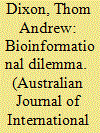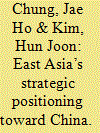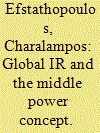| Srl | Item |
| 1 |
ID:
192078


|
|
|
|
|
| Summary/Abstract |
During the South Korean president’s state visit to Australia in December 2021, the Australian Government and in turn the Australian media sustained a narrative that the two countries held ‘common strategic interests’. Over the past ten years, the notion of common strategic interests became a ‘naturalized narrative’ in Australia – a narrative, which through entrenched repetition becomes both natural and inevitable to such an extent that counter-narratives are seen as counterintuitive and open to ridicule.
This study investigates the common strategic interests narrative. It first explores the bilateral relationship and the narrative gap that occurred during the president’s visit. It then turns to the use of language and narrative in bilateral relationships. It looks at how the constituent components supporting the common strategic interests narrative are contextualized and how this impacts the political action of Australia and Korea.
The study finds that the common strategic interests narrative does not cross the linguistic-cultural divide in the Australia-Korea bilateral relationship. The article concludes with policy recommendations. Australia needs to pay more attention to building policy relevance and education links in South Korea.
|
|
|
|
|
|
|
|
|
|
|
|
|
|
|
|
| 2 |
ID:
192077


|
|
|
|
|
| Summary/Abstract |
Bioinformational diplomacy is a field of practice that emerges from the politics of biological information exchange during global public health emergencies. Cyberbiosecurity is a field of practice that emerges from the need to secure material at the interface of the digital and biological worlds from misuse and exploitation. Bioinformational diplomacy arises from the intersection of biologically-derived information becoming acutely valuable to national security actors, and the secrecy with which some valuable bioinformation is handled during global public health emergencies. This article analyses bioinformational diplomacy in relation to cyberbiosecurity and shows that both fields of practice are anchored by the concept of bioinformational secrecy. This paper explores the cooperative exchange and competitive exfiltration of bioinformation using the acute phase of the COVID-19 pandemic as a case study. During the COVID-19 pandemic, states sought to protect and covertly acquire certain types of bioinformation. This highlighted a potentially destabilising security dilemma that requires ongoing management via the practice of bioinformational diplomacy.
|
|
|
|
|
|
|
|
|
|
|
|
|
|
|
|
| 3 |
ID:
192074


|
|
|
|
|
| Summary/Abstract |
Relatively few systematic and categorical studies have been conducted on the variant responses by East Asian states to the rise of China, and even fewer dealt with reasons for such intra-regional variations. This study seeks to fill the void by examining the strategic responses by 15 East Asian states for the period of 2011–2016. This period merits close scrutiny because China became more explicitly assertive. The research proceeds in two phases. First, by way of reading into the expert assessments in academic journals, the strategic responses of the 15 states are categorised into balancing, hedging, or bandwagoning. Second, statistical analyses are conducted to see how the intra-regional variations are related to unit-level factors. Of the seven variables analyzed, three – geographical proximity, democracy, and identity – turn out to be crucial in determining the East Asian states’ strategic responses.
|
|
|
|
|
|
|
|
|
|
|
|
|
|
|
|
| 4 |
ID:
192076


|
|
|
|
|
| Summary/Abstract |
The COVID-19 pandemic poses fundamental challenges to the ways that the discipline of International Relations makes sense of our world. Framing the pandemic as both a social disaster and as part of an ongoing polycrisis, this work argues that existing responses to COVID-19 are, whatever their insights, partial and limited, predicated on assumptions about how we know the world now shown to be problematic. This situation calls less for some defined incremental change and more for a period of uncomfortable disciplinary reflection on the boundaries, purposes and value structures that shape IR.
|
|
|
|
|
|
|
|
|
|
|
|
|
|
|
|
| 5 |
ID:
192079


|
|
|
|
|
| Summary/Abstract |
The premise of Global IR for greater pluralism and inclusivity allows for reconsidering the relevance of established concepts in the IR discipline. This article discusses how Global IR can contribute to rethinking the question of agency in the middle power concept. While the concept has been used in a Western and non-Western context, there is a tendency to adopt a binary distinction between Western middle powers that are conformist in their approach to the liberal international order and Southern middle powers that adopt a reformist stance. The article argues that a Global IR approach can help overcome this dichotomy and open up the study of Western and Southern middle powers to new agential possibilities. To demonstrate this, the article discusses how the cases of Australia and Brazil are not limited to conformist and reformist middle power agencies respectively. The discussion shows how the two states have undergone periods of ambivalence to gradually project new forms of middle power agency that alter and redefine their roles within the liberal international order.
|
|
|
|
|
|
|
|
|
|
|
|
|
|
|
|
| 6 |
ID:
192075


|
|
|
|
|
| Summary/Abstract |
Japan formulated its first infrastructure export strategy in 2010. However, the outputs and effects of that strategy and its successive revisions over the preceding decade have not yet been extensively reviewed. Although infrastructure came to the fore of the international agenda over the past decade, existing research has mostly discussed individual infrastructure projects and accompanying signalling, sloganeering, and strategic communications in the geopolitical and geo-economic context. This paper therefore aims to make an empirical and interpretive contribution to existing scholarship by comprehensively reviewing Japan’s infrastructure exports in 2010–19 and elucidating further its oft-disregarded commercial and developmental aspects. To do so, this article focuses on Official Development Assistance (ODA) loan projects, which count among the largest items of Japan’s infrastructure exports. We introduce and analyse a previously unexamined dataset on infrastructure-related ODA loan projects and contract awards, while also showcasing the avoidance of zero-sum-game approaches in Japan’s related strategy. We then discuss whether and how the changes of Japanese infrastructure export strategy affected the performance of Japan’s infrastructure export through the ODA loan projects as well as Japan’s relationship with the recipient countries, especially in the various parts of the Indo-Pacific region, such as Southeast Asia, South Asia, and Africa.
|
|
|
|
|
|
|
|
|
|
|
|
|
|
|
|